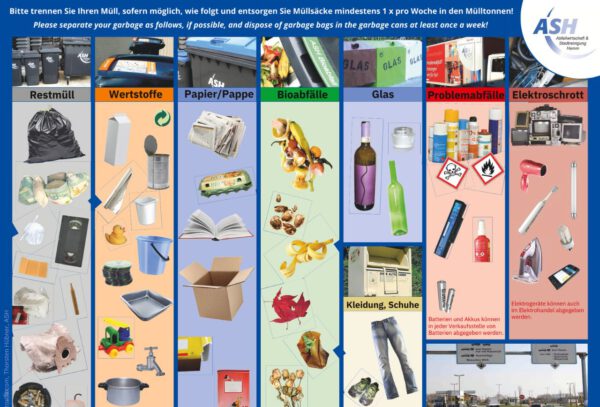Waste Separation in Germany – How to Do It Properly
Germany is considered a pioneer in waste separation and recycling. Proper waste separation helps reuse valuable raw materials, protect the environment, and make waste disposal more efficient. The information sheet from Abfallwirtschaft & Stadtreinigung Hamm (ASH) provides a clear guide to correct waste separation.
Waste generated in the shared apartment should be separated as follows and disposed of in the appropriate bins at least once a week.
1. Residual Waste (Black Bin)
This includes everything that cannot be recycled, such as:
- Diapers and hygiene products
- Vacuum cleaner bags
- Rubber and leather scraps
- Broken ceramics and porcelain
- Cigarette butts
- Contaminated textiles
2. Recyclables (Orange Bin or Yellow Bag)
Recyclable packaging made of plastic and metal should be disposed of here:
- Plastic bottles and packaging
- Yogurt cups
- Tin cans
- Beverage cartons
- Aluminum foil
3. Paper and Cardboard (Blue Bin)
All paper and cardboard waste belongs in the blue bin:
- Newspapers, magazines, books
- Cardboard packaging and boxes
- School notebooks and writing paper
- Egg cartons
4. Organic Waste (Green Bin or Bio Bin – not always available!)
Organic waste is composted and reused as fertilizer. If no bio bin is available, these should be disposed of in the black bin:
- Fruit and vegetable peels
- Coffee filters and tea bags
- Eggshells
- Garden waste (leaves, flowers, small branches)
5. Glass (Glass Recycling Containers)
Glass bottles and containers should be separated by color (white, green, brown) and disposed of in designated glass recycling containers. These containers are not located on the property but are distributed throughout the city center:
- Beverage bottles
- Jam jars
- Mustard and sauce jars
Important: Ceramics, porcelain, and window glass do not belong in glass recycling!
6. Hazardous Waste
Dangerous substances must not be disposed of in household waste. These include:
- Batteries and rechargeable batteries (return at collection points or stores)
- Paints, varnishes, and solvents
- Cleaning agents with hazard symbols
- Medications
7. Electronic Waste
Electronic devices contain valuable metals and must be disposed of separately:
- Household appliances such as irons, hairdryers, or toasters
- Fluorescent tubes and energy-saving lamps
- Smartphones and computers
Many electronic devices can be returned free of charge to stores.
8. Clothing and Shoes
Well-preserved clothing can be donated to collection containers or charitable organizations. Damaged textiles belong in the residual waste.
Why Is Waste Separation Important?
Consistent waste separation allows raw materials to be recycled and reduces environmental pollution. This saves energy and decreases waste incineration. Many materials can be reused to produce new products. Additionally, improperly sorted waste is not collected by the municipal waste service. This leads to accumulating garbage and costly special collections, which are charged to the responsible tenants.
Conclusion
Proper waste separation is not only an important contribution to environmental protection but also helps avoid additional costs due to incorrect bin usage. By following the waste separation guidelines presented in this information sheet, waste can be disposed of correctly and efficiently. Those who follow these rules actively contribute to environmental protection and an effective recycling system in Germany.



